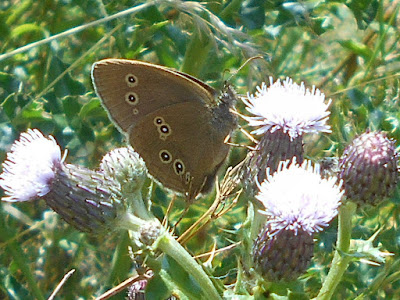Traditional meadows would once have been far richer in species but are now as rare as hens' teeth and need to be cherished. Surely this rich blend of herbs must make the resultant hay more nutritious than that made simply from rye grass. All flesh is grass we are told (Isaiah XL, vi) but this is not to be taken literally. Better perhaps: 'All flesh is a rich blend of monocotyledons and dicotyledons, of herbs and shrubs with, perhaps, the occasional pteridophyte.' On second thoughts perhaps not; it doesn't have quite the same ring. And how sad that the modern garden lawn, often consisting of one grass species and marinated in chemicals, cannot be given the freedom to blaze with like a mini-meadow, with the colours of clovers, speedwells, buttercups, self-heal and golden dandelions. Oh, I forgot: they are weeds.
 |
Ringlet butterflies are regular visitors to thistles. Here on Creeping Thistle,
Foxhill Farm. 28 June, 2018
|
Regarding the thistles, I'll be keeping a close eye on them for the next few weeks as they should receive hordes of insects. The Creeping Thistle, Cirsium arvense, is a noxious weed and its attractiveness to insects does little to appease farmers plagued by this plant. Spear Thistle, Cirsium vulgare, is less of a problem but is nevertheless unwelcome to farmers. Their starfish rosettes are armed with vicious thorns and I have known them to penetrated thin-soled shoes. It is not yet in flower but will only require another week or so for its rather handsome capitula to open.
The three species I have mentioned so far are in the genus Cirsium but there may be Welted Thistles, Carduus acanthoides awaiting discovery. Whatever the genus they will eventually produce masses of seeds, provender for birds such as the Goldfinch. The Latin name for the Goldfinch is Carduelis carduelis, the name being derived from these Carduus thistles. Musk Thistle, Carduus nutans, I have seen growing in an abandoned railway cutting near to Woodford Halse, but not around Badby. However, George Baker (1781-1851) reported the species from Daventry so it may yet occur. |
Spear thistles should be displaying their purple flowers in a week or so.
Foxhill Farm. 28 June, 2018
|
Hogweed, Heracleum sphondylium, will be mown to become part of the crop but there will have been time for beetles to congregate on their flowers. Already hordes of a common species of red soldier beetle, Rhagonycha fulva, are gathering on the creamy umbels.
 |
The black tips to the wing cases help to identify Rhagonycha fulva.
Foxhill Farm. 28 June, 2018
|
They all appear to mature at the same time, maximising their chances of finding a mate. I actually saw two fall to the ground, still in copula.
 |
For some unfathomable reason Rhagonycha fulva is popularly known as
the Hogweed Bonking Beetle. Foxhill Farm. 28 June, 2018
|
As I say, all this frolicking should be over by the time haymaking gets under way. July seems to be a propitious time:
Cut thistles in May
They grow in a day
Cut them in June
That is too soon;
Cut them in July
Then they will die.
The trouble is, as far as Creeping Thistles are concerned - they don't!
* It is said that mediaeval beggars would squeeze buttercup sap on to their skin to induce blistering and so arouse the sympathy of passers-by.















































